After a year and a half away, I returned to The Kilkenny, the magical wild area in the northern sector of the Whites. This day's adventure retraced a route I had navigated back in 1995: a bushwhack ascent of the south (and highest) peak of Terrace Mountain via the fairly short but steep, gravelly slide on its south face. There were no vehicles at the Unknown Pond Trail and York Pond Trail parking areas, and I would have the entire southern Kilkenny to myself on this gorgeous autumn day.
South Terrace presents a striking profile as seen from York Pond Road near the trailhead.
The slide is seen in this view from an open glade on the lower slope of North Weeks (on a previous hike).
Setting out, bound for Willard Notch, the broad, deep gap between North Weeks and South Terrace.
At this crossing of Spring Brook, you "walk the plank." A bit farther along there are two more crossings of the brook and its west branch that generally are not easy.
Peaceful scene along the west branch of Spring Brook.
Walking through wetlands.
Once off the flats, the trail ascends moderately through a fine hardwood forest.
Higher up, the trail swings right up towards Willard Notch through glades of white birch.
White birches are widespread in the Kilkenny forests, having seeded in after a huge 1903 forest fire. Many of these trees have reached the end of their lifespan - much like those on the Rainbow Trail on Carter Dome, another 1903 fire location.
Trail junction in the heart of Willard Notch, a wild and wonderful place. From here, the northbound Kilkenny Ridge Trail heads for South Terrace.
The trail dips to a low point where there is reliable water...
...and a good campsite just above.
There are many marvelous open glades in The Kilkenny. The area has the feel of true wilderness without formal Wilderness designation. The 28,700 acre core of The Kilkenny is protected from logging and road-building as the Kilkenny Roadless Area, under the 2001 Roadless Rule.
There are few trails more pleasurable to walk than the Kilkenny Ridge Trail.
I soon left the trail and headed towards the slide, bushwhacking through more of the gorgeous Kilkenny forest.
Along the way an open glade provided a view across to North Weeks, originally named Round Mountain for obvious reasons.
Before reaching the slide, I made a foray up to a talus slope I had visited years ago on snowshoes.
From the base of the open talus I traversed through a rough area of wooded talus where care was required.
I emerged at the very bottom of the gravelly slide.
Almost immediately there was a view of North Weeks with South Weeks beyond.
From my 1995 trip I knew this slide was very steep and somewhat precarious to climb. A dense growth of ferns - dried husks at this time of year - has flourished on the lower part of the slide. On such a steep slope they presented a unique challenge for footing.
Ascending onto the more open part of the slide, with gravel and loose rock .
Looking back.
Slowly approaching the wide and open upper part of the slide.
Up here, a wild scene of rock, gravel and broken crags.
A side view reveals the steep pitch of this slide - averaging about 40 degrees! The date of this slide is uncertain, but it is fairly old since it shows up in a 1955 aerial photo.
An imposing ledge.
Made it.
This lofty perch opened a beautiful vista across the broad valley known as Willard Basin to South Weeks, the long east ridge of Mt. Waumbek, the double summit of Waumbek, and Mt. Starr King. The valley is drained by Garland Brook and Great Brook. In the 1890s the
Kilkenny Lumber Company logging railroad ran through this valley,
facilitating the clear-cutting of the surrounding slopes. In the 1960s a
major ski area was planned and almost constructed on the north-facing
slopes of Waumbek and Starr King. Now, with the trail access
from the west closed for the last two decades, and that part of York Pond Trail abandoned, this big valley lies in quiet repose. Open hardwoods carpet
the broad floor of the basin, providing fine bushwhacking for those
willing to enter the valley via the longer route over Willard Notch.
Looking down to the flat floor of Willard Notch and across to the great mass of North Weeks. Mt. Washington peeks over the low point on the right.
Long view out to the Mahoosuc Range, with Black Crescent Mountain in the middle distance.
Crags, close-up.
Yup, it's steep. Time to head for the summit.
The first part of the whack was steep and gnarly.
While thrashing around in here, I stumbled upon this wild jutting crag.
A very fine view of Willard Basin here.
Better woods up above.
As I remembered from my previous trip, the slope leveled briefly on a shoulder of ferns and gnarled heart-leaved birches.
Moose beds.
I emerged in a fern meadow that offers good views, just below the 3655-ft. summit (3645 ft. on Lidar). Terrace received its name due to its terraced appearance from certain angles. In 1885 AMC explorer Eugene B. Cook descended Mt. Weeks (then called Round Mtn.) and noted that “Between it and the Pilot Range is a mountain formed in part of terraces.”
Mts. Adams, Jefferson, Washington and Monroe peer over between North and South Weeks.
The spur path that leads to the summit of South Terrace from the Kilkenny Ridge Trail is lined with wiry heart-leaved birches.
Battered sign.
The Kilkenny Ridge Trail makes a long, circling sidehill descent around the east side of the mountain, with some rocky footing.
More birches!
Shuffling through the fluffy leaves back down to the valley, ending another great trek in The Kilkenny.


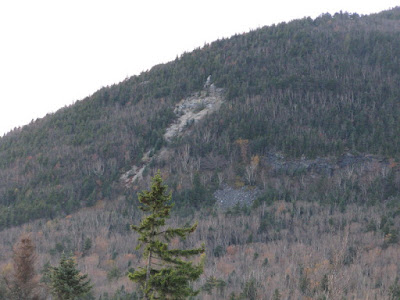











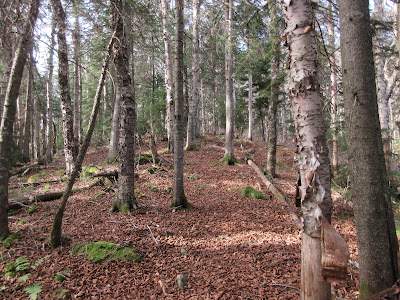





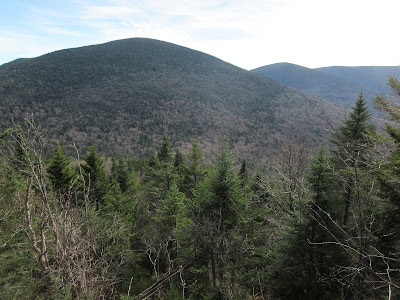


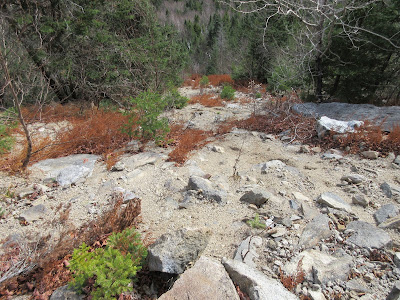













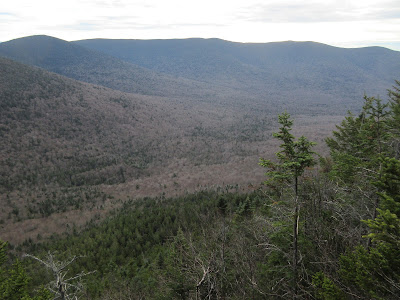





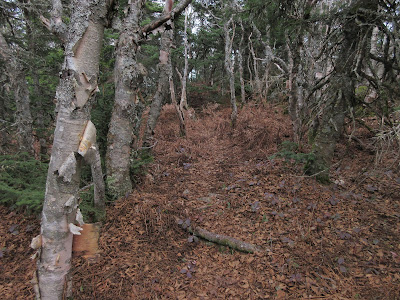




No comments:
Post a Comment